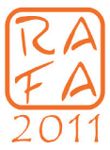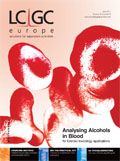Event News
Upcoming Events
The 5th International Symposium on Recent Advances in Food Analysis (RAFA 2011)
Conference organizers, the Institute of Chemical Technology in Prague, the Institute of Food Safety (RIKILT) in The Netherlands and the International Association of Environmental Analytical Chemistry (IAEAC), would like to invite all food scientists from universities, research institutes, national and international agencies, governmental and commercial laboratories, industry and other food business-related companies to attend the 5th International Symposium on Recent Advances in Food Analysis (RAFA) 2011 at the Clarion Congress Hotel Prague, Czech Republic, 1–4 November 2011.

Novel analytical applications in food research and a routine analysis are required to meet quality control (QC) and food safety criteria, comply with legal and labelling requirements, determine nutritional value and to detect food fraud/adulteration. It should be noted that, in spite of the legislative efforts, food scandals occasionally occur and can originate from contamination from pesticide residues, veterinary drug residues, endocrine disruptors, processing contaminants, migration from packaging materials or natural sources (including mycotoxins and marine toxins). Additionally, since modern biotechnology methods have been introduced to food production, GM food and food ingredients have become an issue and have led to a strong demand for adequate methods of analysis.
As a result the science of food analysis is a rapidly evolving and exciting field. In all cases, sampling strategy, sample analysis, data handling and final exposure assessment are crucial steps that are closely interrelated. The desired level of consumer protection and the strict regulation of maximum limits force analytical chemists in food laboratories to lower quantification limits, improve QA/QC and increase sample throughput by introducing new approaches and highly innovative technologies, including the use of bioassays for bioactivity and toxicity screening; omics-based analysis including metabolomics-like profiling; on-line and at-line analysis approaches; spectrometric food profiling (NMR, NIR); (bio)nanotechnology and chip-based methods; solvent-free and other emerging isolation technologies; and hyphenated techniques such as LC–MS and MS–MS, fast GC–TOF-MS, GC–MS–MS, ambient MS and/or comprehensive chromatography (GC×GC, LC×LC).
At the last RAFA conference in 2009, 530 scientists from 55 countries participated. Fifty seven oral communications (including 13 young scientists') and 440 posters were presented within the scientific programme. Ten vendor seminars and two satellite workshops were also organised. Scientific committee and organizers of the RAFA 2011 aim to prepare a balanced programme with high-quality presentations followed by stimulating discussions, several satellite events, a state-of-the-art exhibition and an attractive social programme.
Scientific contributions will be presented by leading scientists through key note lectures and contributed oral and poster presentations. Moreover, a platform for young scientists to present their scientific work will be offered. RAFA 2011 Student Travel Grants will be also provided. The best poster presentation(s) by a young scientist(s) will be awarded. Several satellite events are planned currently to accompany the conference programme.
An exhibition of the modern instruments used in food analysis will be on display during the symposium. Vendor seminars will be also organized to introduce recent instrumentation and scientific strategies for advanced food quality/safety control. Oral presentations can be submitted until 31 July 2011, poster presentations until 31 August 2011.
For further information contact Monika Tomaniova on +420 605 423 973, e-mail RAFA2011@vscht.cz or go to the website at www.rafa2011.eu
19–23 June 2011
HPLC 2011
Budapest Congress and World Trade Centre, Budapest, Hungary
Tel: +36 1 2250210
Fax: +36 1 2012680
E-mail: diamond@diamond-congress.hu
Website: www.hplc2011.com
21–23 June 2011
15th Annual Green Chemistry and Engineering Conference
ACS Green Chemistry Institute, Washington DC, USA
Tel: +1 202 872 6102
Fax: +1 202 872 6206
E-mail: gci@acs.org
Website: www.acs.org/gci
9–11 July 2011
Chirality 2011
Sherrington Building, University of Liverpool, UK
Tel: +44 151 795 0422
Fax: +44 151 795 5256
E-mail: chir2011@liv.ac.uk
Website: www.liv.ac.uk/chirality2011
21–25 August 2011
Dixon 2011
Crowne Plaza, Brussels, Belgium
Tel: +32 2 739 3028
Fax: +32 2 743 1550
E-mail: dioxin2011@mci-group.com
Website: www.dioxon2011.org
5–9 September 2011
The 17th International Symposium on Separation Sciences (17-ISSS)
Hall of Grand Hotel Napoca, Cluj-Napoca, Romania
Tel: +40 264 55 11 75
Fax: +40 264 55 11 75
E-mail: 17isss-secretariat@event-consulting.ro
Website: www.17issscluj2011.org
Send any event news to Doug Kitson at dkitson@advanstar.com

Understanding FDA Recommendations for N-Nitrosamine Impurity Levels
April 17th 2025We spoke with Josh Hoerner, general manager of Purisys, which specializes in a small volume custom synthesis and specialized controlled substance manufacturing, to gain his perspective on FDA’s recommendations for acceptable intake limits for N-nitrosamine impurities.
University of Rouen-Normandy Scientists Explore Eco-Friendly Sampling Approach for GC-HRMS
April 17th 2025Root exudates—substances secreted by living plant roots—are challenging to sample, as they are typically extracted using artificial devices and can vary widely in both quantity and composition across plant species.
Determining the Serum Proteomic Profile in Migraine Patients with LC–MS
April 17th 2025Researchers used liquid chromatography–mass spectrometry (LC–MS) in their proteomic analysis to compare the serum proteome of migraine patients with healthy controls and to identify differentially expressed proteins as potential migraine biomarkers.











